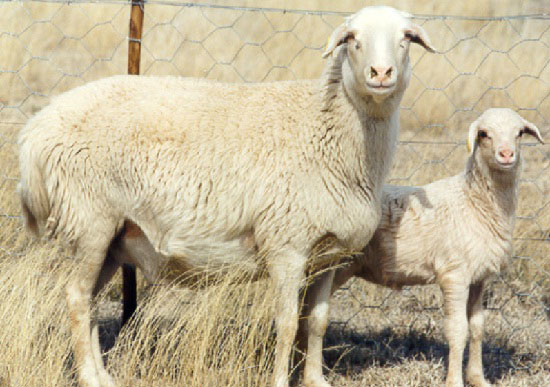
RARE BREEDS TRUST OF AUSTRALIA
powered by TidyHQSheep: Ronderib Afrikaner
Sheep: Ronderib Afrikaner
Country of Origin 
South Africa
Australian Status

International Status
Critical
Uses
 Meat, Pelts
Meat, Pelts
Breed traits
There are two varieties of Afrikaner sheep: the Namaqua Afrikaner and the Ronderib Afrikaner. Both have the long, fat tail which stores energy enabling them to survive long, dry seasons. When the fat breaks down it provides energy and water at the same time.
The Ronderib Afrikaner is one of the larger breeds of the indigenous South African sheep, and it has two sub varieties:
- Blinkhaar Ronderib, with soft, fine, shiny hair and
- Coarse haired Steekhaar Ronderib Afrikaner, which was thought to be extinct until 1995, when twenty sheep were found at a farm near the Northern Cape town of Upington.
The breed is distinguished by its distinctive coat and its ribs which are oval, rather than flat in cross section. The body is covered with a light cream fleece of soft wool with smooth, glossy hairs. The body covering is shed in summer. The breed is very adept at living in desert conditions and can survive for long periods with little or no water.
Adult rams and ewes can reach 60- 80kilograms and the rams usually have amber coloured horns with one and a half turns, although some polled rams do exist. Ewes can have small horns or none at all. Rams show a mane on the neck and under the neck to the point of the chest. The head is quite long and narrow with a concave profile and Roman nose. The tail is very distinctive and has three sections. It can weigh 8-12kilograms and reach down to near the hocks. A corkscrew tail or tail hanging to one side is considered a breed fault.
The trend towards more lean meat had a negative effect on the Ronderib Afrikaner which was a mutton breed. Purebred lambs grow slowly and although they reach slaughter mass at 6-7months old, they do not present a good grade carcase, so are better marketed at 10-12 months.
The ewes are highly prolific and have relatively high reproduction performance rates. They can be bred successfully at an early age and mated throughout the year.
The hide of the Ronderib Afrikaner is highly sought after to make skin blankets, although this is a specialised craft undertaken by few people. The skins also qualify as "Cape Glover" and bring good prices for the manufacture of fine leather gloves.
History
The Afrikaner sheep is a breed of fat tailed, hair sheep indigenous to South Africa. They are one of the oldest native sheep breeds, along with breeds such as the Damara and the Black headed Persian. The breed was found with the Hottentots when the first white people arrived at the Cape in 1652. They are also thought to be the first sheep imported to Australia, with the First Fleet in 1788, so their history here is a long one.
History in Australia
Although the Ronderib Afrikaner was brought to Australia with the First Fleet, the breed disappeared with the introduction of the Merino. It was reintroduced to Australia with the importation of embryos in 1999.
Australian Population
Ewes: 60 (2017)
Breed Organisation
Not known
